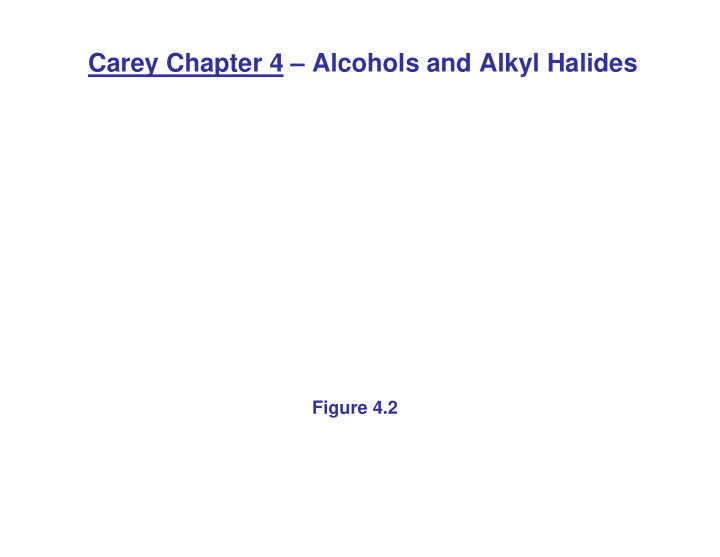



Carey Chapter 4 – Alcohols and Alkyl Halides Figure 4.2
4.1 Functional groups – a look ahead
4.2 IUPAC nomenclature of alkyl halides • Functional class nomenclature Br I Cl pentyl chloride cyclohexyl bromide 1-methylethyl iodide • Substitutive nomenclature Cl Br I CH 3 2-bromopentane 3-iodopropane 2-chloro-5-methylheptane
4.3 IUPAC nomenclature of alcohols OH OH OH 2-propanol 1-pentanol cyclohexanol OH H 3 C OH OH CH 3 2-pentanol 1-methyl 5-methyl- cyclohexanol 2-heptanol
4.4 Classes of alcohols and alkyl halides Primary (1 o ) Br Cl OH Secondary (2 o ) OH I Cl Tertiary (3 o ) CH 3 Br Cl (CH 3 ) 3 COH CH 2 CH 3
4.5 Bonding in alcohols and alkyl halides Figure 4.1
4.5 Bonding in alcohols and alkyl halides Figure 4.2
4.6 Physical properties – intermolecular forces CH 3 CH 2 CH 3 CH 3 CH 2 F CH 3 CH 2 OH propane fluoroethane ethanol b.p. -42 o C -32 o C 78 o C Figure 4.4
4.6 Physical properties – water solubility alcohols Figure 4.5 Alkyl halides are generally insoluble in water (useful)
4.7 Preparation of alkyl halides from alcohols and HX R OH + H X R X + H O H hydrogen halide alkyl halide alcohol water solvent H O H OH Br H Br NaBr, H 2 SO 4 OH Br heat
4.8 Mechanism of alkyl halide formation
4.8 Energetic description of mechanism Step 1 - protonation Figure 4.6
4.8 Energetic description of mechanism Step 2 – carbocation formation Figure 4.7
4.8 Energetic description of mechanism Step 3 – trapping the carbocation Figure 4.9
4.9 Full mechanism “pushing” curved arrows H Cl H 3 C H 3 C H 3 C C O H H 3 C C Cl H O H H 3 C H 3 C H Cl Cl H 3 C H H O H CH 3 H 3 C C O H C H 3 C CH 3 H 3 C Cl
4.9 Full S N 1 mechanism showing energy changes Figure 4.11
4.10 Carbocation structure and stability Figure 4.8 Figure 4.15 Hyperconjugation
4.10 Relative carbocation stability Figure 4.12
4.11 Relative rates of reaction of R 3 COH with HX Relative Rates of Reaction for Different Alcohols with HX R R R H R C OH R C OH H C OH H C OH > > > R H H H Related to the stability of the intermediate carbocation: CH 3 CH 3 CH 3 H > > > H 3 C CH 3 H 3 C H H H H H
4.11 Relative rates of reaction of R 3 COH with HX Figure 4.16 Rate-determining step involves formation of carbocation
4.12 Reaction of methyl and 1 o alcohols with HX – S N 2
4.12 Substitution Reaction Mechanism - S N 2 R δ - δ + RCH 2 OH 2 X CH 2 OH 2 X X CH 2 R + H 2 O Transition state • Alternative pathway for alcohols that cannot form a good carbocation • Rate determining step is bimolecular (therefore S N 2) • Reaction profile is a smooth, continuous curve (concerted)
4.13 Other methods for converting ROH to RX Cl OH Br SOCl 2 PBr 3 • Convenient way to halogenate a 1 o or 2 o alcohol • Avoids use of strong acids such as HCl or HBr • Usually via S N 2 mechanism
4.14 Free Radical Halogenation of Alkanes R-H + X 2 R-X + H-X Types of bond cleavage: X : Y X : Y heterolytic X Y homolytic X : Y
4.15 Free Radical Chlorination of Methane ∆ CH 4 + Cl 2 CH 3 Cl + HCl (~400 o C) ∆ CH 3 Cl + Cl 2 CH 2 Cl 2 + HCl (~400 o C) ∆ CH 2 Cl 2 + Cl 2 CHCl 3 + HCl (~400 o C) ∆ CHCl 3 + Cl 2 CCl 4 + HCl (~400 o C)
4.16 Structure and stability of Free Radicals CH 3 CH 3 CH 3 H > > > H 3 C CH 3 H 3 C H H H H H Orbital hybridization models of bonding in methyl radical ( Figure 4.17 )
4.16 Bond Dissociation Energies (BDE)
4.17 Mechanism of Methane Chlorination
4.17 Mechanism for Free Radical Chlorination of Methane : Initiation Cl Cl 2 Cl Cl H : CH 3 Cl : H CH 3 Propagation : Cl : CH 3 Cl Cl CH 3 Cl CH 3 CH 3 Termination CH 3 : CH 3 Cl Cl : CH 3 CH 3
4.18 Free Radical Halogenation of Higher Alkanes 420 o C CH 3 CH 3 + Cl 2 CH 3 CH 2 Cl + HCl 78% h ν CH 3 CH 2 CH 2 CH 3 + Cl 2 CH 3 CH 2 CH 2 CH 2 Cl CH 3 CHCH 2 CH 3 28% 72% Cl + HCl Radical abstraction of H is selective since the stability of the ensuing radical is reflected in the transition state achieved during abstraction. δ δ δ δ Cl H CH 2 CH 2 CH 2 CH 3 Cl H CHCH 2 CH 3 CH 3 Lower energy, formed faster
4.18 Free Radical Halogenation of Higher Alkanes Figure 4.16
4.18 Bromine radical is more selective than chlorine Br 2 + HBr h ν Br 76%, only product Consider propagation steps – endothermic with Br · , exothermic with Cl · Chlorination – early TS looks Bromination – late TS looks a less like radical lot like radical
Recommend
More recommend